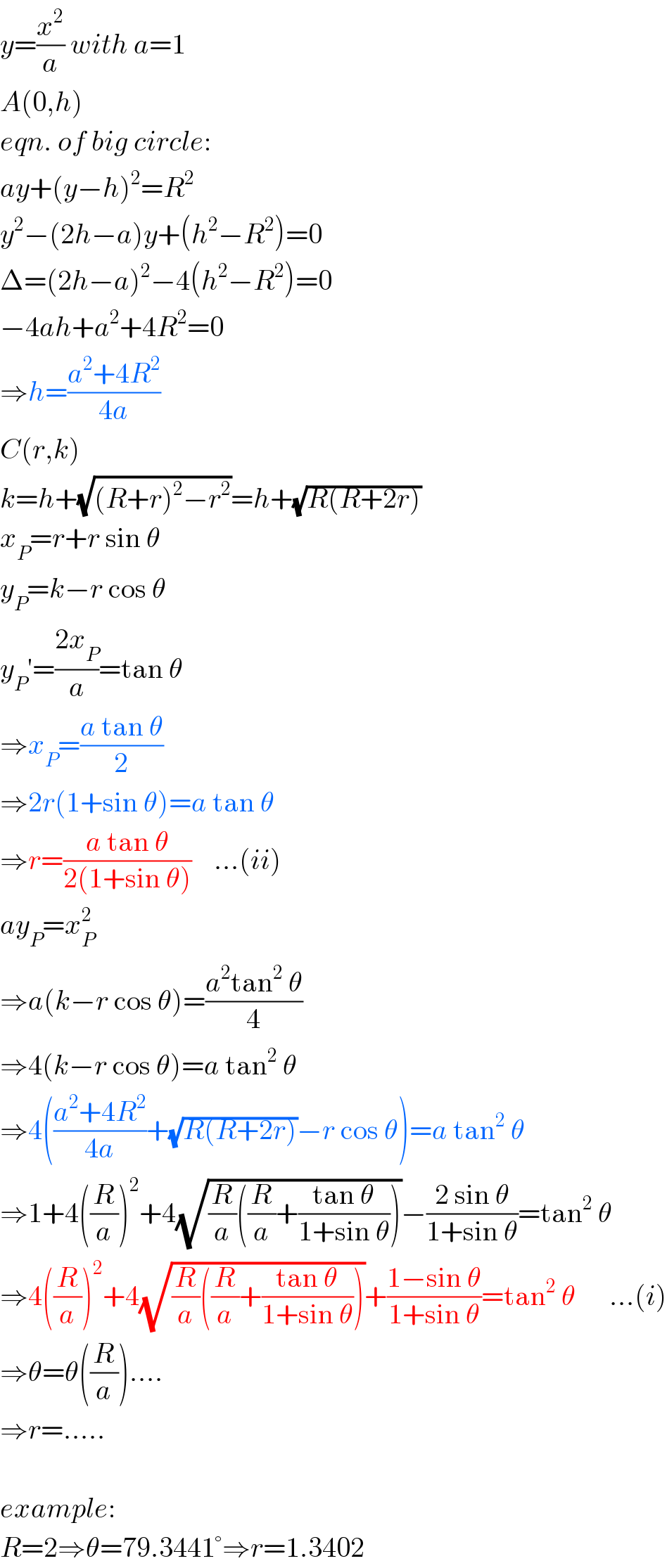Question Number 53323 by ajfour last updated on 20/Jan/19

Answered by mr W last updated on 20/Jan/19

$${y}=\frac{{x}^{\mathrm{2}} }{{a}}\:{with}\:{a}=\mathrm{1} \\ $$$${A}\left(\mathrm{0},{h}\right) \\ $$$${eqn}.\:{of}\:{big}\:{circle}: \\ $$$${ay}+\left({y}−{h}\right)^{\mathrm{2}} ={R}^{\mathrm{2}} \\ $$$${y}^{\mathrm{2}} −\left(\mathrm{2}{h}−{a}\right){y}+\left({h}^{\mathrm{2}} −{R}^{\mathrm{2}} \right)=\mathrm{0} \\ $$$$\Delta=\left(\mathrm{2}{h}−{a}\right)^{\mathrm{2}} −\mathrm{4}\left({h}^{\mathrm{2}} −{R}^{\mathrm{2}} \right)=\mathrm{0} \\ $$$$−\mathrm{4}{ah}+{a}^{\mathrm{2}} +\mathrm{4}{R}^{\mathrm{2}} =\mathrm{0} \\ $$$$\Rightarrow{h}=\frac{{a}^{\mathrm{2}} +\mathrm{4}{R}^{\mathrm{2}} }{\mathrm{4}{a}} \\ $$$${C}\left({r},{k}\right) \\ $$$${k}={h}+\sqrt{\left({R}+{r}\right)^{\mathrm{2}} −{r}^{\mathrm{2}} }={h}+\sqrt{{R}\left({R}+\mathrm{2}{r}\right)} \\ $$$${x}_{{P}} ={r}+{r}\:\mathrm{sin}\:\theta \\ $$$${y}_{{P}} ={k}−{r}\:\mathrm{cos}\:\theta \\ $$$${y}_{{P}} '=\frac{\mathrm{2}{x}_{{P}} }{{a}}=\mathrm{tan}\:\theta \\ $$$$\Rightarrow{x}_{{P}} =\frac{{a}\:\mathrm{tan}\:\theta}{\mathrm{2}} \\ $$$$\Rightarrow\mathrm{2}{r}\left(\mathrm{1}+\mathrm{sin}\:\theta\right)={a}\:\mathrm{tan}\:\theta \\ $$$$\Rightarrow{r}=\frac{{a}\:\mathrm{tan}\:\theta}{\mathrm{2}\left(\mathrm{1}+\mathrm{sin}\:\theta\right)}\:\:\:\:…\left({ii}\right) \\ $$$${ay}_{{P}} ={x}_{{P}} ^{\mathrm{2}} \\ $$$$\Rightarrow{a}\left({k}−{r}\:\mathrm{cos}\:\theta\right)=\frac{{a}^{\mathrm{2}} \mathrm{tan}^{\mathrm{2}} \:\theta}{\mathrm{4}} \\ $$$$\Rightarrow\mathrm{4}\left({k}−{r}\:\mathrm{cos}\:\theta\right)={a}\:\mathrm{tan}^{\mathrm{2}} \:\theta \\ $$$$\Rightarrow\mathrm{4}\left(\frac{{a}^{\mathrm{2}} +\mathrm{4}{R}^{\mathrm{2}} }{\mathrm{4}{a}}+\sqrt{{R}\left({R}+\mathrm{2}{r}\right)}−{r}\:\mathrm{cos}\:\theta\right)={a}\:\mathrm{tan}^{\mathrm{2}} \:\theta \\ $$$$\Rightarrow\mathrm{1}+\mathrm{4}\left(\frac{{R}}{{a}}\right)^{\mathrm{2}} +\mathrm{4}\sqrt{\frac{{R}}{{a}}\left(\frac{{R}}{{a}}+\frac{\mathrm{tan}\:\theta}{\mathrm{1}+\mathrm{sin}\:\theta}\right)}−\frac{\mathrm{2}\:\mathrm{sin}\:\theta}{\mathrm{1}+\mathrm{sin}\:\theta}=\mathrm{tan}^{\mathrm{2}} \:\theta \\ $$$$\Rightarrow\mathrm{4}\left(\frac{{R}}{{a}}\right)^{\mathrm{2}} +\mathrm{4}\sqrt{\frac{{R}}{{a}}\left(\frac{{R}}{{a}}+\frac{\mathrm{tan}\:\theta}{\mathrm{1}+\mathrm{sin}\:\theta}\right)}+\frac{\mathrm{1}−\mathrm{sin}\:\theta}{\mathrm{1}+\mathrm{sin}\:\theta}=\mathrm{tan}^{\mathrm{2}} \:\theta\:\:\:\:\:\:…\left({i}\right) \\ $$$$\Rightarrow\theta=\theta\left(\frac{{R}}{{a}}\right)…. \\ $$$$\Rightarrow{r}=….. \\ $$$$ \\ $$$${example}: \\ $$$${R}=\mathrm{2}\Rightarrow\theta=\mathrm{79}.\mathrm{3441}°\Rightarrow{r}=\mathrm{1}.\mathrm{3402} \\ $$
Commented by ajfour last updated on 20/Jan/19

$${Thanks}\:{Sir},\:{very}\:{lucent}\:{manner}! \\ $$
